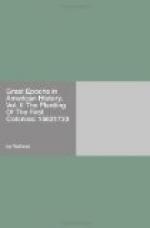This was a horrible winter to the advanced guard of English settlers on the upper Connecticut. The navigation of the river was completely blocked by ice before the middle of November; and the vessels which were to have brought their winter supplies by way of Long Island Sound and the river were forced to return to Boston, leaving the wretched settlers unprovided for. For a little while some scanty supplies of corn were obtained from the neighboring Indians, but this resource soon failed. About seventy persons straggled down the river to the fort at its mouth. There they found and dug out of the ice a sixty-ton vessel, and made their way back to Boston. Others turned back on the way they had come, and struggled through the snow and ice to “the Bay.” But a few held their grip on the new territory. Subsisting first on a little corn bought from more distant Indians, then by hunting, and finally on ground-nuts and acorns dug from under the snow, they fought through the winter and held their ground. But it was a narrow escape. Spring found them almost exhausted, their unsheltered cattle dead, and just time enough to bring necessary supplies from home. The Dorchester people alone lost cattle to the value of two thousand pounds.
The Newtown congregation, in October, 1635, found customers for their old homes in a new party from England; and in the following June Hooker and Stone led their people overland to Connecticut. They numbered one hundred, with one hundred and sixty head of cattle. Women and children were of the party. Mrs. Hooker, who was ill, was carried on a litter; and the journey, of “about one hundred miles,” occupied two weeks. Its termination was well calculated to dissipate the evil auguries of the previous winter. The Connecticut Valley in early June! Its green meadows, flanked by wooded hills, lay before them. Its oaks, whose patriarch was to shelter their charter, its great elms and tulip-trees, were broken by the silver ribbon of the river; here and there were the wigwams of the Indians, or the cabins of the survivors of the winter; and, over and through all, the light of a day in June welcomed the newcomers. The thought of abandoning Connecticut disappeared forever.
[1] From Johnston’s
“History of Connecticut.” By permission
of, and
by arrangement with, the authorized
publishers, Houghton, Mifflin
Co. Copyright, 1887,
by Alexander Johnston.
WITCHCRAFT IN NEW ENGLAND
(1647-1696)
BY JOHN G. PALFREY[1]
The people of Massachusetts in the seventeenth century, like all other Christian people at that time and later,—at least, with extremely rare individual exceptions,—believed in the reality of a hideous crime called witchcraft. They thought they had Scripture for that belief, and they knew they had law for it, explicit and abundant; and with them law and Scripture were absolute authorities for the regulation of opinion and of conduct.




